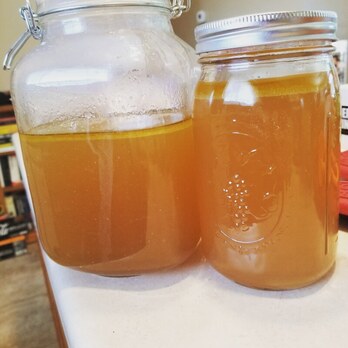 Whoa, hold on, an original recipe? Yes, that’s right. We’re doing this again. This week, I had a lot of time to myself which lead to trying something I have never done before: making my own chicken stock. Even as I type this out for you now, I have a hard time deciding if I made stock or broth, since most of the pieces of chicken I used still had some meat left on them. Indeed, I had a whole leg in there with my discarded pieces from earlier in the week to make sure I used every ounce of chicken in my fridge. If for no other reason than the heavier nature of the Normal Chicken Stock, we’re going to call it a stock regardless of the amount of meat salvaged from the whole chicken leg I used to get the flavor into it. This recipe is purely for using up bones or bits carved off from the chicken you use on a regular basis, whether it be a whole chicken or leg quarters. You just need stuff with the bones in it.
And that’s the Normal Chicken Stock! You can freeze it or keep in in the fridge for a little while if you intend to use it within a few days. A lot of fat can congeal on the top despite straining off the stock. If you don’t like this, you can pull the fat out once the stock has cooled in the fridge. The fat is good for ramen, which is what I used part of my first batch for.
0 Comments
Leave a Reply. |
The MissionAn idea born in Normal, Illinois, Eating Normal hopes to chronicle the eating Experiences of a Red bird. Pledge monthly to our patreon!
Or, you know, support the mission with caffeine! Buy me a coffee through Ko-Fi. Archives
May 2020
Categories
All
|

 RSS Feed
RSS Feed